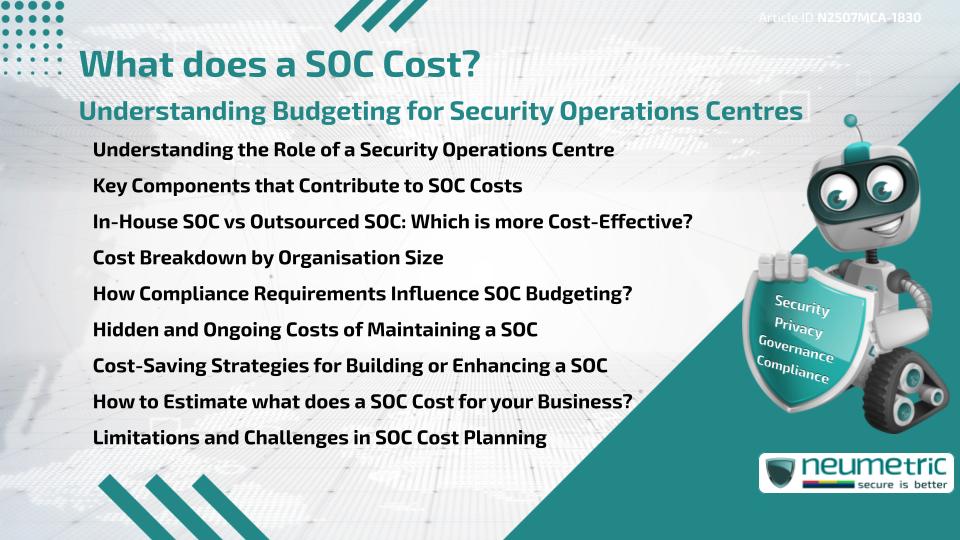Table of Contents
ToggleIntroduction
Security Operations Centres [SOCs] are essential for modern Cybersecurity, helping businesses detect, respond to & mitigate Threats in real-time. However, the common question many organisations face when planning their Cybersecurity roadmap is: what does a SOC cost? The answer is not as straightforward as listing prices. SOC costs vary based on size, complexity, staffing, tools & service delivery models.
In this article, we will break down the various elements that influence SOC expenses, compare cost models & guide you on how to effectively plan & budget for SOC implementation or optimisation.
Understanding the Role of a Security Operations Centre
A Security Operations Centre [SOC] is a centralised team responsible for continuously monitoring & improving an organisation’s security posture. It uses a combination of People, Processes & Technologies to detect, analyse & respond to Cybersecurity Incidents.
But what does a SOC cost when you factor in the Technology stack, Expert personnel & ongoing Threat Intelligence? Before getting to that, it helps to understand the scope of a SOC’s responsibilities. These include:
- Monitoring Network Traffic & System Logs
- Investigating Security Alerts
- Conducting Threat hunting
- Managing Incident Response
- Ensuring Regulatory Compliance
Each of these tasks involves specific Tools, skilled Professionals & regular Updates all of which directly influence the total cost.
Key Components that Contribute to SOC Costs
When asking what does a SOC cost, consider the following components that drive your budgeting:
Personnel
Hiring skilled Security Analysts, Threat hunters & Incident Responders is one of the most expensive elements. Salaries, Benefits & Training all add up.
Technology Stack
A SOC typically includes Security Information & Event Management [SIEM] Tools, Endpoint Detection & Response [EDR], Intrusion Detection Systems & Firewalls. Licensing & Deployment costs vary widely.
Infrastructure
In-house SOCs require Physical Space, Servers, Backup Systems & Power redundancy each adding to operational costs.
Processes & Workflows
Documenting, testing & maintaining Response Procedures consumes time & resources, especially when aligning with Frameworks such as NIST or MITRE ATT&CK.
Compliance & Reporting
SOC responsibilities often include Continuous Monitoring for GDPR, SOC 2, HIPAA or ISO 27001 each adding to workload & tools needed.
In-House SOC vs Outsourced SOC: Which is more Cost-Effective?
A fundamental budgeting decision lies in whether to build a SOC in-house or outsource it to a Managed Security Service Provider [MSSP].
- In-House SOC: Offers more control but involves high Capital & Operational expenditure.
- Outsourced SOC: More scalable & predictable, but less control over Tools & Response strategy.
So what does a SOC cost under each model?
| Model | Estimated Monthly Cost | Key Considerations |
| In-House SOC | ₹ 10 lakhs – ₹ 20 lakhs | Best for Large Enterprises |
| Outsourced SOC | ₹ 4 lakhs – ₹ 12 lakhs | Suitable for Small to Mid-size Firms |
Outsourced models often come with Service-Level Agreements [SLAs], around-the-clock Coverage & quicker Onboarding.
Cost Breakdown by Organisation Size
What does a SOC cost for Small Startups versus Large Enterprises?
- Small Business (under 30 Employees): May rely on part-time services or virtual SOCs costing ₹ 1 lakh – ₹ 3 lakhs per month.
- Mid-Sized Business (30 – 200 Employees): Typically invest ₹ 4 lakhs – ₹ 8 lakhs monthly for Hybrid SOCs.
- Large Enterprises (200+ Employees): Full in-house SOCs can cost upwards of ₹ 20 lakhs monthly due to Staffing & Tooling requirements.
Each scale introduces different challenges in visibility, complexity & Compliance and the cost scales accordingly.
How Compliance Requirements influence SOC Budgeting?
SOC activities often align with Industry & Regional Compliance mandates. For example:
- Healthcare Firms must monitor for HIPAA requirements.
- Financial Institutions must comply with PCI DSS.
- Tech Firms handling European Data must follow GDPR.
What does a SOC cost when Compliance is critical? Typically, around 20 – 30 Percent higher than basic monitoring services. Compliance-grade Logging, Data Retention, Audit Trails & real-time Alerting significantly increase Operational needs.
Hidden & Ongoing Costs of maintaining a SOC
One of the most overlooked aspects in SOC budgeting is the recurring cost. Beyond initial setup, Organisations incur:
- Continuous Training to retain Analyst competency
- Tool upgrades & Licensing renewals
- Threat Intelligence feeds & Subscriptions
- Audit preparation & reporting
What does a SOC cost if you fail to plan for these ongoing needs? Unanticipated costs can exceed original estimates by 40 Percent over three (3) years.
Cost-Saving Strategies for Building or Enhancing a SOC
Cost does not always need to be a blocker. Here are practical ways to optimise SOC spend:
- Start Small: Deploy minimum viable monitoring & scale up.
- Use Open-Source Tools: Like Wazuh for Intrusion Detection.
- Adopt Shared SOC Services: Join Industry-specific or Regional Security collectives.
- Automate: Integrate automated response via Playbooks & SOAR Platforms.
Asking what does a SOC costs becomes easier when approached with strategic milestones rather than all-at-once implementation.
How to Estimate what does a SOC Cost for your Business?
You can build an estimation Framework based on:
- Number of endpoints monitored
- Expected Incident Response time
- Number of Compliance standards met
- Staffing requirements & shift coverage
- Preferred tooling (Commercial vs Open-source)
Work with your internal IT or Cybersecurity Team to benchmark actual needs. A simple worksheet can reveal surprising gaps in your budgeting assumptions.
Limitations & Challenges in SOC Cost Planning
Even with good planning, determining what does a SOC costs is not always accurate. Factors like market shifts in Cybersecurity Talent, Tool inflation & Compliance changes can disrupt even the best-laid budgets.
Also, the ROI from a SOC is not always financial it includes Risk reduction, Reputational protection & Operational resilience, which are hard to quantify.
Takeaways
- SOC costs vary widely by size, model & compliance Requirements.
- In-house SOCs offer control but demand higher Budgets & Staffing.
- Outsourced SOCs provide affordability & quick scalability.
- Ongoing & hidden costs like Training & Tool renewal are often underestimated.
- Strategic planning with Compliance needs in mind helps manage costs effectively.
FAQ
What does a SOC cost for a Small Business?
A Small Business typically spends between ₹ 1 lakh – ₹ 3 lakhs monthly, often by using Outsourced or Virtual SOC Services to minimise cost.
What does a SOC cost if built In-house?
An In-house SOC can cost ₹ 10 lakh – ₹ 20 lakhs or more monthly, including Salaries, Tools, Infrastructure & Training.
What are the hidden costs in SOC Operations?
Hidden costs include Staff turnover, Licensing renewals, Infrastructure upgrades & Training Programs.
What does a SOC cost per Analyst?
Each analyst may cost ₹ 1 lakh – ₹ 3 lakhs monthly depending on Experience, Location & required Shift Coverage.
Can Compliance Requirements increase SOC cost?
Yes, meeting frameworks like GDPR or HIPAA can increase costs by 20 – 30 Percent due to Logging, Monitoring & Reporting needs.
Is an Outsourced SOC more budget-friendly?
Yes, Outsourced SOCs generally cost less upfront & are ideal for Businesses lacking Internal Cybersecurity Staff.
What tools add to SOC cost?
SIEM, EDR, firewalls & Threat Intelligence Platforms are core tools that significantly influence costs.
How long does it take to break even on SOC investment?
Most Businesses start seeing measurable Risk reduction ROI within one (1) to two (2) years, depending on Incident rates.
Does a Cloud-native SOC cost less?
Cloud-native or virtual SOCs reduce Infrastructure & Maintenance costs but may limit Control & Customisation.
Need help?
Neumetric provides organisations the necessary help to achieve their Cybersecurity, Compliance, Governance, Privacy, Certifications & Pentesting goals.
Organisations & Businesses, specifically those which provide SaaS & AI Solutions, usually need a Cybersecurity Partner for meeting & maintaining the ongoing Security & Privacy needs & requirements of their Clients & Customers.
SOC 2, ISO 27001, ISO 42001, NIST, HIPAA, HECVAT, EU GDPR are some of the Frameworks that are served by Fusion – a centralised, automated, AI-enabled SaaS Solution created & managed by Neumetric.
Reach out to us!


